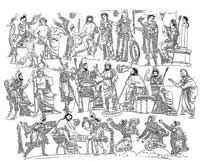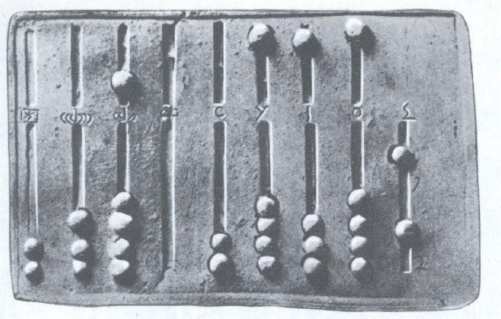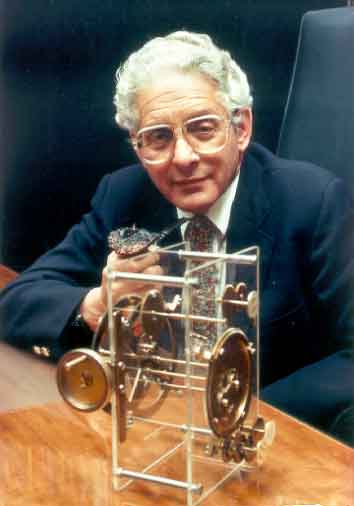|
|
Der Mechanismus von Antikythera In 1900 Greek sponge drivers discovered an astonishingly intricate mechanism in Antikythera, an island near Crete. A Greek sponge diver, Elias Stadiatos, discovered the wreck of a cargo ship with statues lying on the seabed that made the greatest impression on him. He returned to the surface, removed his helmet, and gabbled that he had found a heap of dead, naked women. The ship's cargo of luxury goods also included jewellery, pottery, fine furniture, wine and bronzes dating back to the first century BC. But the most important finds proved to be a few green, corroded lumps—the last remnants of an elaborate mechanical device. The device was in the shipwreck of a commercial boat dated at the first century BC located near to cape Glyfada in Potamakia position 60m under the sea and 30m from the shore of the small island of Antikythera. This device now known as the Antikythera device represents the most sophisticated machinery found to date from antiquity; as such its importance is hard to overestimate. Map of Antikythera with the position where the device was found Its complexity is far in advance of that what was expected from a device that was build about 80 BC (recently new studies suggest it was build even earlier between 150 and 100 BC). The part found contains 32 gears. Its use of a Differential Gear to subtract the sidereal motion of the sun from that of the moon to produce the synodic month, the cycle of the phases of the moon, is remarkable and represents the first example of such gearing yet discovered. The full functions of the mechanism may never be known but it appears certain that it displayed the position of the Sun in the zodiac throughout the year as well as the phases of the moon. As such it can be considered as one of the first known computing devices. Price (1974) speculated that it may also have displayed the positions of the planets as well, thought the gearing required to do this is missing from the fragments that were recovered. “Planetaria” are considered have been also build by Archimedes and they also could be used for educational and research purposes. Some consider that it could be produced in Rhodes which was considered technological advanced and had the knowledge supported by scientists like Hipparchus or Posidonius from Rhodes. Also machines like the repeating Catapult of Dionysius were products from Rhodes. Price for example considers some link of the device with Geminus from Rhodes. Compare this device with the Abacus (αβάκιο) used for calculations by the Greeks and Romans.
The Abacus, Abax (latin), or Abaq (Sumeric), giving the general idea of an Algorithmic Unit (ALU) of a computer, is coming in use in the far east. Abaq or Abax stands for dust. Thus using the Abax or Abaq meant writing in dust. The Abax serves as a means to calculate, it is a flat stone or wooden tabletop in which are carved straight lines. Calculations are done using little pebbles, and it is assumed that the various pebbles represent different values. In much later times (approximately 800 AD), the Abax showed up in Europe. Built around 87 B.C.
The Synodic Month It was the requirement of displaying the phases of the moon based on the Synodic month of about 29 ½ that necessitates a complex gear train to subtract the revolutions of the Sun from those of the Moon to produce the cycles of the synodic months. It was precisely this requirement that lead to the development of the Differential Turntable which is the single most astounding feature of the Antikythera mechanism. The Differential Turntable
Price (1974) states that: “The differential turntable is certainly the most spectacular mechanical feature of the Antikythera device because of its extreme sophistication and lack of any historical precedent” Price also comments that there are people who would rather attribute the creation of the mechanism to visiting alien astronauts rather than accept that our forbears possessed the technical knowledge and engineering ability to design and construct such a complex device over two-thousand years ago. The gears were designed to approximate a astronomical ratio 13.368267 that was approximated by the ratio 254/19 = 13.36842105 which represents an accuracy of 1/86000. According to the results presented by the American Mathematical Society an explanation could be that the astronomers observed an almost exact duplication of the pattern of equinoxes and solstices (sun) and phases of the moon in a 19-year cycle. The Athenian astronomer Meton (fifth century B.C.), for example, noted that 19 years almost exactly matches 235 synodic months, which correspond to 235+19=254 revolutions of the moon with respect to the stars. It picks up an extra one each year from its trip with us around the sun. The analysis with continued fractions shows that much more complex gears (with more teeths) would be required to approach the next better approximation expressed as ratio 4465/334. In the publication „ Antikythera Mechanism, Challenging the Classical Research“ (PDF File ) some of these findings are considered and the results is that some of the results are interpretations with great uncertainty. The Antikythera device is a unique piece that forces us to consider that out knowledge of ancient science and technology is rather limited. Michael Wright, a curator of mechanical engineering at the Science Museum in London used a new detailed X-ray analysis technique called linear tomography to study the device. By moving an X-ray source, the film and the object being investigated relative to one another features in a particular plane come into focus. The resulting images were analyzed with Allan Bromley, a computer scientist at Sydney University. The result is that Price was wrong in several respects. In some cases, says Mr Wright, Price seems to have “massaged” the number of teeth on particular gears (most of which are, admittedly, incomplete) in order to arrive at significant astronomical ratios. Price's account also, he says, displays internal contradictions, selective use of evidence and unwarranted speculation. In particular, it postulates an elaborate reversal mechanism to get some gears to turn in the right direction.Since so little of the mechanism survives, some guesswork is unavoidable. But Mr Wright noticed a fixed boss at the centre of the mechanism's main wheel. To his instrument-maker's eye, this was suggestive of a fixed central gear around which other moving gears could rotate. This does away with the need for Price's reversal mechanism and leads to the idea that the device was specifically designed to model a particular form of “epicyclic” motion. Mr Wright found evidence that the Antikythera mechanism would have been able to reproduce the motions of the sun and moon accurately, using an epicyclic model devised by Hipparchus, and of the planets Mercury and Venus, using an epicyclic model derived by Apollonius of Perga. A device that modelled only the motions of the sun, moon, Mercury and Venus does not make much sense. But if an upper layer of mechanism had been built, and lost, these extra gears could have modelled the motions of the three other planets known at the time—Mars, Jupiter and Saturn. In other words, the device may have been able to predict the positions of the known celestial bodies for any given date with a respectable degree of accuracy, using bronze pointers on a circular dial with the constellations of the zodiac running round its edge. If we consider the remarks of Price that according to Cicero (Cic. Nat de. 2.34-35) Posidonius built a much more complicated astronomical computer than the one recovered then we may ask if similar devices will be found in the future. Cicero in the first century BC, mentions an instrument “recently constructed by our friend Posidonius, which at each revolution reproduces the same motions of the sun, the moon and the five planets.” It is difficult to believe that the Antikythera device is a unique piece of antiquity and the most advanced that survived. RealSlideShow: The Antikythera Mechanism Bibliography
|
| ||||||||||||||||












